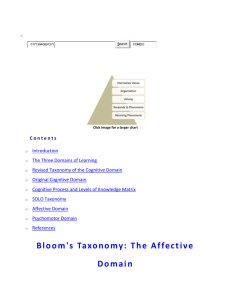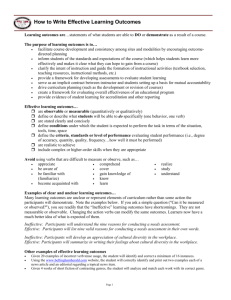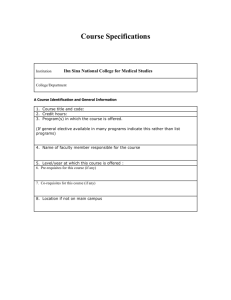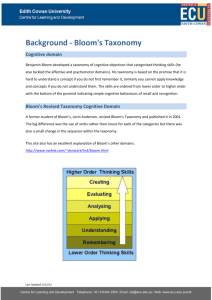Taxonomy of Objective`s Behaviors
advertisement
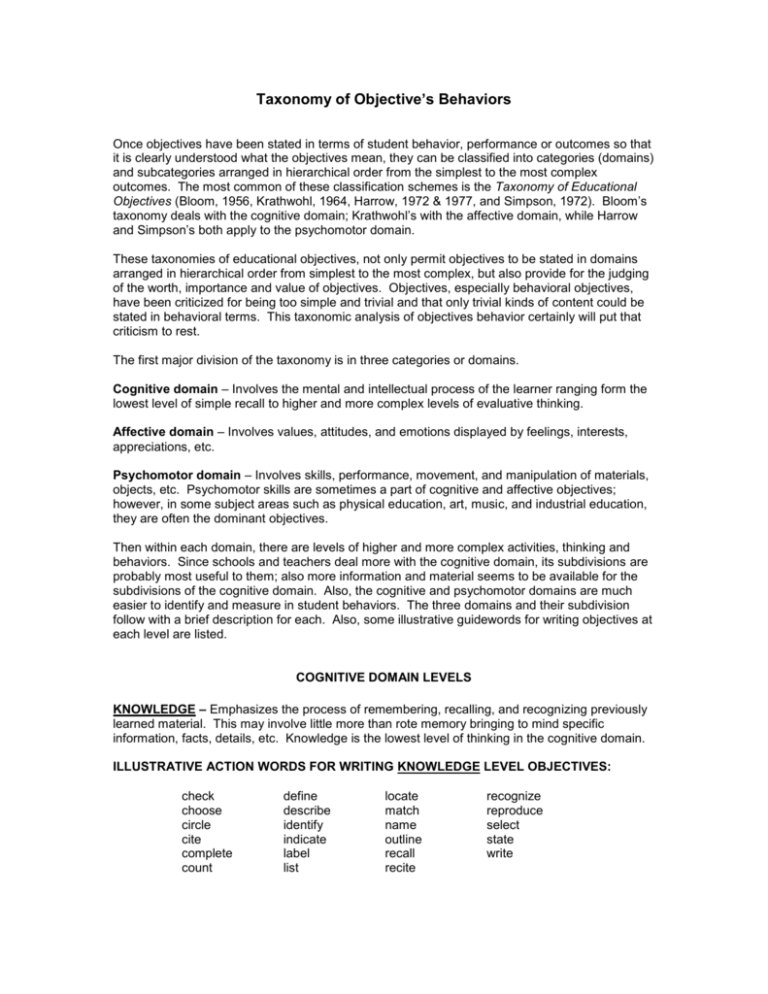
Taxonomy of Objective’s Behaviors Once objectives have been stated in terms of student behavior, performance or outcomes so that it is clearly understood what the objectives mean, they can be classified into categories (domains) and subcategories arranged in hierarchical order from the simplest to the most complex outcomes. The most common of these classification schemes is the Taxonomy of Educational Objectives (Bloom, 1956, Krathwohl, 1964, Harrow, 1972 & 1977, and Simpson, 1972). Bloom’s taxonomy deals with the cognitive domain; Krathwohl’s with the affective domain, while Harrow and Simpson’s both apply to the psychomotor domain. These taxonomies of educational objectives, not only permit objectives to be stated in domains arranged in hierarchical order from simplest to the most complex, but also provide for the judging of the worth, importance and value of objectives. Objectives, especially behavioral objectives, have been criticized for being too simple and trivial and that only trivial kinds of content could be stated in behavioral terms. This taxonomic analysis of objectives behavior certainly will put that criticism to rest. The first major division of the taxonomy is in three categories or domains. Cognitive domain – Involves the mental and intellectual process of the learner ranging form the lowest level of simple recall to higher and more complex levels of evaluative thinking. Affective domain – Involves values, attitudes, and emotions displayed by feelings, interests, appreciations, etc. Psychomotor domain – Involves skills, performance, movement, and manipulation of materials, objects, etc. Psychomotor skills are sometimes a part of cognitive and affective objectives; however, in some subject areas such as physical education, art, music, and industrial education, they are often the dominant objectives. Then within each domain, there are levels of higher and more complex activities, thinking and behaviors. Since schools and teachers deal more with the cognitive domain, its subdivisions are probably most useful to them; also more information and material seems to be available for the subdivisions of the cognitive domain. Also, the cognitive and psychomotor domains are much easier to identify and measure in student behaviors. The three domains and their subdivision follow with a brief description for each. Also, some illustrative guidewords for writing objectives at each level are listed. COGNITIVE DOMAIN LEVELS KNOWLEDGE – Emphasizes the process of remembering, recalling, and recognizing previously learned material. This may involve little more than rote memory bringing to mind specific information, facts, details, etc. Knowledge is the lowest level of thinking in the cognitive domain. ILLUSTRATIVE ACTION WORDS FOR WRITING KNOWLEDGE LEVEL OBJECTIVES: check choose circle cite complete count define describe identify indicate label list locate match name outline recall recite recognize reproduce select state write COMPREHENSION – Represents the lowest level of understanding but is a step above simply recalling knowledge. It involves interpreting, translating, summarizing, or paraphrasing information, but not necessarily to the extent of relating it to other material or understanding its fullest implications. Comprehension goes one step beyond simple memorizing and is the second level in the cognitive domain. ILLUSTRATIVE ACTION WORDS FOR WRITING COMPREHENSION LEVEL OBJECTIVES: change classify conclude convert demonstrate derive describe differentiate distinguish estimate expand explain express extend extrapolate generalize give example indicate infer interpret paraphrase predict rearrange restate rewrite summarize translate transform APPLICATION – Refers to the use of learned material in new and real situations or abstract knowledge in concrete situations. This may include the application of such abstractions as general concepts, principles, theories, rules and laws to real or concrete problems. Learning outcomes at this level require a higher degree of thinking than those at comprehension and knowledge. ILLUSTRATIVE ACTIONS WORDS FOR WRITING APPLICATION LEVEL OBJECTIVES: apply arrange build change classify collect complete compile compute construct demonstrate develop diagram discover discuss dramatize employ generalize illustrate make manipulate model modify operate order organize participate perform plan predict prepare produce prove reconstruct record relate report show solve state teach transfer use ANALYSIS – Involves the breakdown of a whole into its separate elements until the relationship among those elements is made clear. In addition to the analysis of its elements, it includes an analysis of relationships, and organizational principles, arrangement and structure, which holds the parts together as a whole. Objectives and learning outcomes here require a very high level of thinking because they involve an understanding of both content and the structural form of the material. This is the fourth level of the cognitive domain and includes the use of the first three levels. analyze associate breakdown categorize chart classify compare conclude contrast debate deduce design detect determine diagram differentiate dissect discriminate distinguish generalize graph illustrate infer investigate order organize outline point out relate separate subdivide summarize survey SYNTHESIS – Involves combining the elements or parts of something to form a new or original whole. This can be the bringing together of previously learned content with new information to form an original entity. It requires a very high level of thinking that can lead to creative and innovative behavior. This level of thinking is exceeded only by evaluation and builds on the first four levels of Bloom’s cognitive domain. One of the most common examples of teachers using synthesis is their development of teaching units. They bring together various parts and elements to create a new original plan of their own. arrange categorize classify combine compile compose constitute construct create design develop devise document forecast formulate generate incorporate integrate invent modify organize originate plan predict produce propose rearrange reconstruct relate reorganize revise rewrite summarize synthesize transmit EVALUATION – Involves acts of judgment and decision making about the value of something. Those judgments are to be based on clearly defined criteria and for a given purpose. These criteria may be objective or subjective and are usually predetermined. Evaluation is the highest level of Bloom’s cognitive domain and contains elements of all the other levels. Also, evaluation is a bridge from the cognitive to the affective domain. As with analysis and synthesis, subjective or essay type test questions are almost always written at the evaluation level. ILLUSTRATIVE ACTION WORDS FOR WRITING EVALUATION LEVEL OBJECTIVES: argue appraise assess compare conclude contrast criticize decide determine distinguish discriminate dispute evaluate grade interpret judge justify rank rate relate standardize summarize support validate verify weigh Note that some of the action words are identified as appropriate for writing objectives at two or three levels of the cognitive domain and a few are even appropriate for the affective and psychomotor domains as well. The only individual knowing exactly the level at which an objective is written is the one who writes it. When reading behavioral objectives, it is sometimes difficult to determine if they are written at the analysis, synthesis or evaluation level; however, at this point of decision, it is very easy to see that they are not stated at the knowledge (rote memory) level. Occasionally, it is necessary for students to learn certain knowledge and remember it before they are ready to grasp the next higher level of thinking called for in the cognitive domain. To make teaching most effective, objectives should be included from all levels of this cognitive domain as well as from the affective and psychomotor domains.
